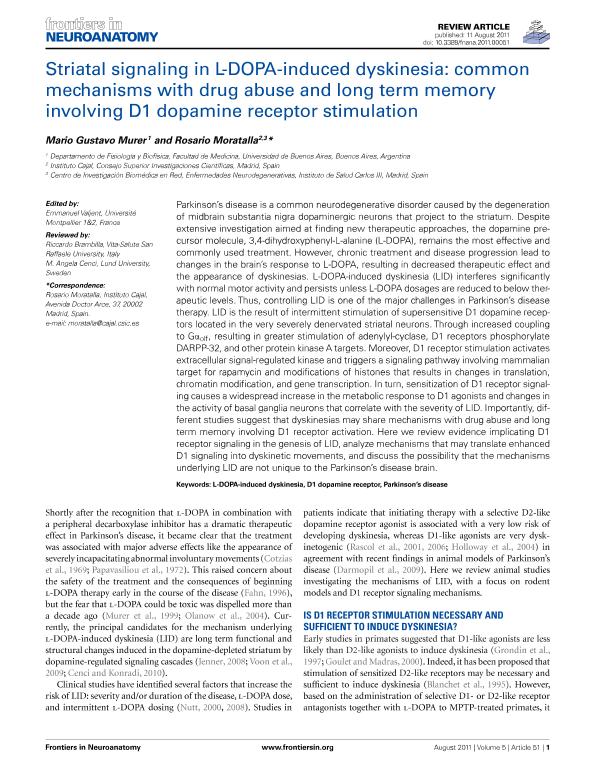Mostrar el registro sencillo del ítem
dc.contributor.author
Murer, Mario Gustavo

dc.contributor.author
Moratalla, Rosario
dc.date.available
2017-02-10T21:32:53Z
dc.date.issued
2011-08
dc.identifier.citation
Murer, Mario Gustavo; Moratalla, Rosario; Striatal signaling in L-DOPA-induced dyskinesia: common mechanisms with drug abuse and long term memory involving D1 dopamine receptor stimulation; Frontiers; Frontiers in Neuroanatomy; 5; 51; 8-2011; 1-12
dc.identifier.issn
1662-5129
dc.identifier.uri
http://hdl.handle.net/11336/12899
dc.description.abstract
Parkinson's disease is a common neurodegenerative disorder caused by the degeneration of midbrain substantia nigra dopaminergic neurons that project to the striatum. Despite extensive investigation aimed at finding new therapeutic approaches, the dopamine precursor molecule, 3,4-dihydroxyphenyl-l-alanine (l-DOPA), remains the most effective and commonly used treatment. However, chronic treatment and disease progression lead to changes in the brain's response to l-DOPA, resulting in decreased therapeutic effect and the appearance of dyskinesias. l-DOPA-induced dyskinesia (LID) interferes significantly with normal motor activity and persists unless l-DOPA dosages are reduced to below therapeutic levels. Thus, controlling LID is one of the major challenges in Parkinson's disease therapy. LID is the result of intermittent stimulation of supersensitive D1 dopamine receptors located in the very severely denervated striatal neurons. Through increased coupling to Gα(olf), resulting in greater stimulation of adenylyl-cyclase, D1 receptors phosphorylate DARPP-32, and other protein kinase A targets. Moreover, D1 receptor stimulation activates extracellular signal-regulated kinase and triggers a signaling pathway involving mammalian target for rapamycin and modifications of histones that results in changes in translation, chromatin modification, and gene transcription. In turn, sensitization of D1 receptor signaling causes a widespread increase in the metabolic response to D1 agonists and changes in the activity of basal ganglia neurons that correlate with the severity of LID. Importantly, different studies suggest that dyskinesias may share mechanisms with drug abuse and long term memory involving D1 receptor activation. Here we review evidence implicating D1 receptor signaling in the genesis of LID, analyze mechanisms that may translate enhanced D1 signaling into dyskinetic movements, and discuss the possibility that the mechanisms underlying LID are not unique to the Parkinson's disease brain.
dc.format
application/pdf
dc.language.iso
eng
dc.publisher
Frontiers

dc.rights
info:eu-repo/semantics/openAccess
dc.rights.uri
https://creativecommons.org/licenses/by-nc-sa/2.5/ar/
dc.subject
Parkinson´S Disease
dc.subject
Dyskinesia
dc.subject
Levodopa
dc.subject.classification
Neurociencias

dc.subject.classification
Medicina Básica

dc.subject.classification
CIENCIAS MÉDICAS Y DE LA SALUD

dc.title
Striatal signaling in L-DOPA-induced dyskinesia: common mechanisms with drug abuse and long term memory involving D1 dopamine receptor stimulation
dc.type
info:eu-repo/semantics/article
dc.type
info:ar-repo/semantics/artículo
dc.type
info:eu-repo/semantics/publishedVersion
dc.date.updated
2017-02-09T18:23:41Z
dc.journal.volume
5
dc.journal.number
51
dc.journal.pagination
1-12
dc.journal.pais
Suiza

dc.description.fil
Fil: Murer, Mario Gustavo. Universidad de Buenos Aires. Facultad de Medicina; Argentina. Consejo Nacional de Investigaciones Científicas y Técnicas. Oficina de Coordinación Administrativa Houssay; Argentina
dc.description.fil
Fil: Moratalla, Rosario. Consejo Superior de Investigaciones Cientificas; España. Instituto de Salud Carlos III; España
dc.journal.title
Frontiers in Neuroanatomy
dc.relation.alternativeid
info:eu-repo/semantics/altIdentifier/url/http://journal.frontiersin.org/article/10.3389/fnana.2011.00051/full
Archivos asociados
